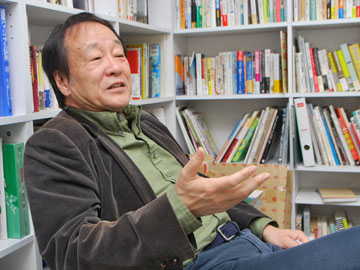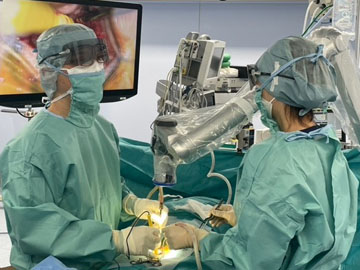
I am writing this message from a hospital room at Suita Municipal Hospital, near my university. The day before yesterday I had neurosurgery, under general anesthesia, for lumbar spinal canal stenosis—a narrowing of the spinal canal that leads to reduced blood flow and to pinching of the nerves between bones and ligaments. The disorder had brought pain in the back of my thighs and numbness in my toes that made it difficult for me to walk for any great length. The doctors said this is due to aging, although I believe I am still young enough.
The doctors performed the surgery while looking at the affected area using a specially designed stereo-microscope, the Exoscope. Instead of viewing through an eyepiece, the surgeon, other surgical staff, and even the residents watching the surgery for educational purposes used polarized eyeglasses to see the stereoscopic image on a large, high-resolution display. This was not the first time I had encountered optical technology in an operating room. Another surgery more than 10 years ago, for the treatment of cataracts in both eyes, relied on advanced laser and ultrasound technology, on the implantation of intraocular multifocal replacement lenses, and on optical coherence tomography to precisely image my retina.
 Dr. Masao Umegaki (left), during my recent surgery. [Photo courtesy of M. Umegaki]
Dr. Masao Umegaki (left), during my recent surgery. [Photo courtesy of M. Umegaki]
The doctor in my recent spinal surgery graduated from the University of Tokyo in chemistry, went to medical school at the University of Osaka and is now an established neurosurgeon. The professor of ophthalmology in my previous cataract surgery received a master of science in applied physics at the University of Tokyo, also followed up by medical school at the University of Osaka. These examples suggest that combining a background in multiple areas within a single person can sometimes create greater synergy than, for example, having a medical doctor work with a separate physicist or a chemist.
Optical and photonic technology draws from many different disciplines—and finds applications across society.
Optical and photonic technology likewise draws from many different disciplines—and finds applications across society. Not only in operating rooms but throughout the hospital, state-of-the-art lasers, microscopes, endoscopes and spectroscopic diagnostic and analytical equipment are used; other exciting potential applications will no doubt emerge from the Optica Biophotonics Congress, which will take place this month in Ft. Lauderdale, FL, USA. Beyond the clinic, optics has been used for observing the stars and planets with telescopes, in military research, in semiconductor manufacturing, in fiber communications, in smartphones, and in countless other places.
Unquestionably, as these examples illustrate, science and technology have great power to improve human lives. Yet history has shown that they can also be dangerous if used improperly. On 3 February, in my first Optica board meeting as the society’s president, one of the main topics of discussion was the potential misuse of advanced optical and photonic technology for face recognition. Given the world’s current instability, solving such “dual use” problems in the application of advanced science and technology will call for considerable wisdom and thought—from all of us.
I look forward hearing from you on these topics and future messages at ideas@optica.org.
—Satoshi Kawata,
Optica President
